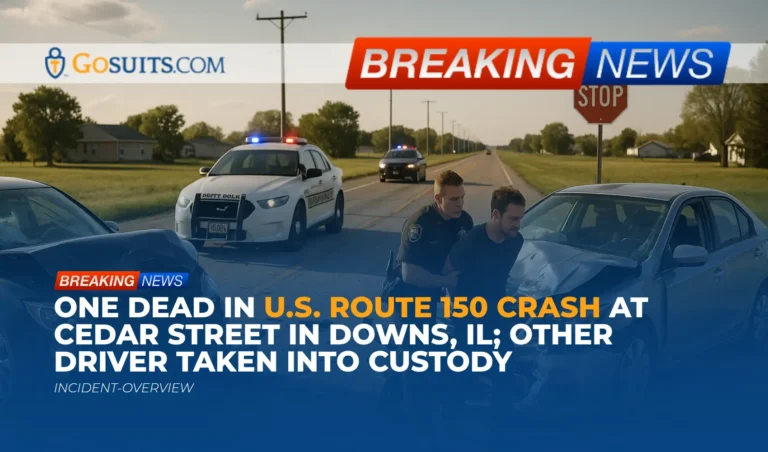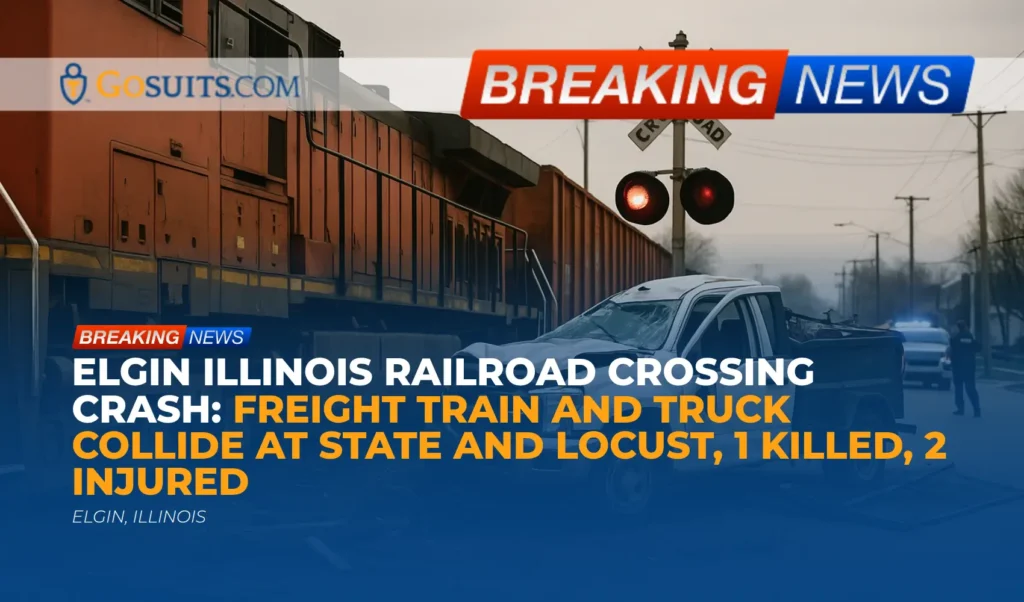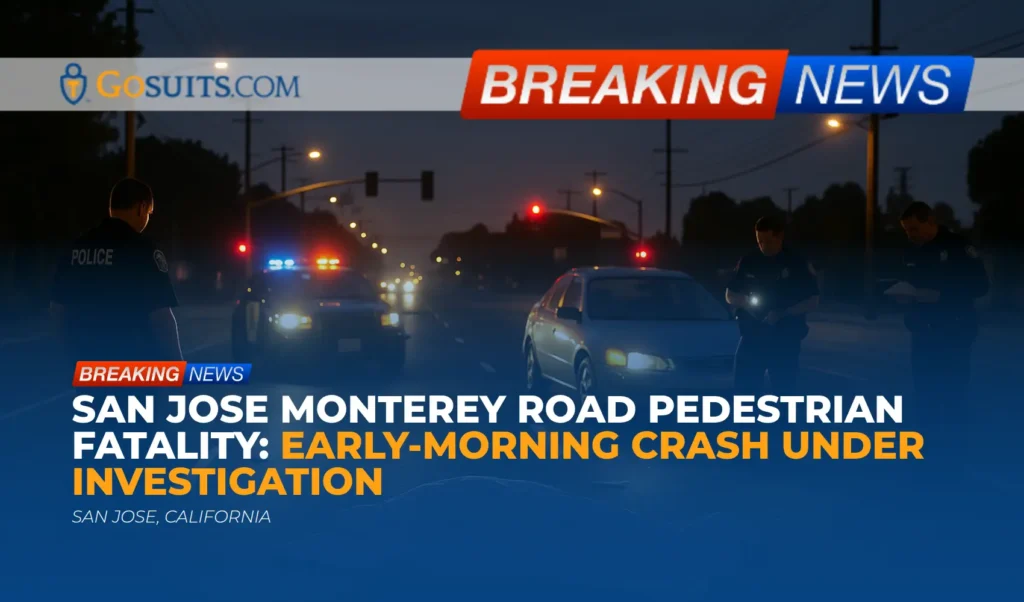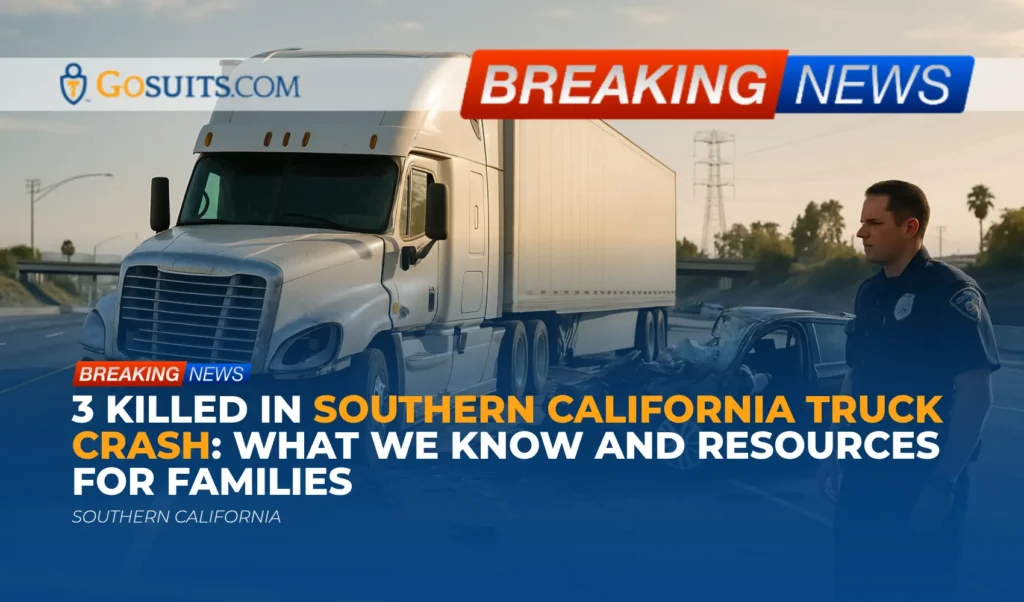- Incident overview and what is confirmed
- Location, timing, and roadway context
- Law enforcement status and investigative steps
- What this means under Illinois civil law
- Immediate steps to protect evidence and rights
- Where to request official records and documents
- How crashes like this are reconstructed
- Insurance layers that may be involved
- Safety context for rural corridors and intersections
- Timelines and statutes that commonly apply
- What to expect next in the official process
- Compassionate resources and practical support
- Commentary from Gosuits Downs, Illinois Personal Injury Attorney
- Why timely action matters after a serious crash
Incident overview and what is confirmed
According to preliminary information released by the Illinois State Police, a two-vehicle collision occurred near Downs in McLean County, Illinois, at approximately 3:25 p.m. on Saturday. The crash took place on U.S. Route 150 at Cedar Street. Based on the initial report, a car traveling eastbound on Route 150 struck a westbound vehicle. The driver of the westbound vehicle died from injuries sustained in the crash. Troopers also reported that the other driver attempted to leave the scene, was taken into custody, and was transported to a hospital for treatment. A portion of Route 150 was closed for investigation and scene safety.
These details reflect early reports and may be refined as the investigation develops. When serious injuries or a fatality are involved, official agencies typically conduct a thorough reconstruction and gather physical, digital, and testimonial evidence before issuing a final report.
Location, timing, and roadway context
The collision occurred in the Downs area of McLean County, Illinois, on U.S. Route 150 at Cedar Street. Route 150 is a key regional corridor that connects rural and small-town communities. Intersections along rural routes can present visibility and speed management challenges, especially where traffic control, sight distance, and turning movements intersect with higher posted speeds.
Any crash analysis will consider the time of day (mid-afternoon), traffic conditions, weather, roadway design features (such as lane width, shoulder condition, and signage), and any temporary factors (construction zones or detours) that could have influenced driver behavior and vehicle dynamics.
Law enforcement status and investigative steps
The Illinois State Police responded and closed part of Route 150 to secure the scene. In a fatal crash investigation, it is common for troopers and crash reconstruction officers to:
- Document the scene with measurements, photographs, and diagrams, including debris fields, vehicle resting positions, and skid or yaw marks.
- Collect vehicle data such as airbag control module information and other event data recorder (EDR) downloads when available.
- Interview witnesses, involved drivers (as appropriate), and responding personnel for timelines and observations.
- Coordinate with the county coroner to document injuries, collect medical information relevant to cause of death, and arrange for autopsy and toxicology when indicated by county policy.
EDRs in many vehicles record speed, brake application, seatbelt status, and other parameters in the seconds before a crash. The National Highway Traffic Safety Administration provides a general overview of EDRs and their role in crash analysis at NHTSA’s Event Data Recorder page.
What this means under Illinois civil law
When a fatal traffic collision occurs, Illinois civil law provides pathways for surviving family members to pursue claims related to the loss, and for the decedent’s estate to pursue claims that the decedent could have brought had they survived. While each case is unique and dependent on evidence, the legal framework generally includes the following:
Wrongful Death claims
Illinois’ Wrongful Death Act permits designated survivors to bring an action for damages resulting from a death caused by another’s wrongful act or negligence. Damages may include pecuniary losses and, by statute, grief, sorrow, and mental suffering of the next of kin. For statutory guidance, see the Illinois Wrongful Death Act at the Illinois General Assembly site: 740 ILCS 180.
Survival claims
The Illinois Survival Act allows certain causes of action that the decedent could have brought during life to continue through the estate. That can include claims for pain and suffering experienced before death, medical expenses, and other damages as supported by the evidence. See the Survival Act at 755 ILCS 5/27-6.
Comparative negligence
Illinois follows a modified comparative negligence system. Damages may be reduced in proportion to a claimant’s share of fault, and recovery is generally barred if a claimant is more than 50 percent at fault. The statute is at 735 ILCS 5/2-1116. In fatal crash cases, allocating fault depends on a careful analysis of physical evidence, witness accounts, and expert reconstruction.
Leaving the scene and civil considerations
Illinois law requires drivers involved in crashes with injury or death to remain at the scene and render aid. See 625 ILCS 5/11-401. While criminal responsibility is separate from civil liability, evidence that a driver attempted to leave the scene may be considered in assessing negligence and, depending on the facts, may influence the types of damages a civil court allows. Any such assessment is fact-specific and determined through the civil litigation process.
Prejudgment interest in bodily injury and death cases
Illinois permits prejudgment interest in certain personal injury and wrongful death actions, subject to statutory requirements and exceptions. See 735 ILCS 5/2-1303. Whether interest applies, from what date, and at what rate depend on the statute and the case’s procedural posture.
Immediate steps to protect evidence and rights
After a serious crash, families are often overwhelmed by grief, logistics, and unanswered questions. The civil justice process relies heavily on evidence that can quickly disappear if not preserved. Thoughtful steps taken early can make a significant difference later.
- Consult a qualified attorney before speaking with any insurance company. Insurance representatives may reach out quickly. What is said can be recorded and used in later claim decisions. An early, confidential consultation can help identify rights, obligations, and next steps, and it helps ensure communications are accurate and protected.
- Preserve vehicles and key components. Vehicles carry critical evidence, including airbag modules, lights, and mechanical systems. If a vehicle is towed to a yard, ask that it be preserved without alterations and that no destructive inspections occur until all parties agree on protocols.
- Collect and secure documents. Keep copies of any discharge paperwork, billing statements, and correspondence from hospitals or first responders. Preserve photos, videos, dashcam footage, and the names and contact information for witnesses.
- Document the scene and injuries. If safe and appropriate, photographs of the road, signage, weather conditions, and any visible injuries can be invaluable for timeline and impact analysis.
- Avoid social media discussion. Public posts can be misinterpreted or taken out of context. It is generally prudent to keep details private while the facts are being established.
Where to request official records and documents
Official records help establish what happened and why. In a fatal crash near Downs, requests often involve state police, the county coroner, and public health authorities. The following resources are authoritative .gov sources for records and guidance.
Illinois State Police crash reports
The Illinois State Police maintains a portal for obtaining crash reports. Availability depends on the stage of the investigation and any legal restrictions. Visit the ISP Crash Reports page at https://isp.illinois.gov/CrashReports for instructions on how to request a report, required information, and any associated fees. The main ISP site is https://isp.illinois.gov.

McLean County Coroner’s Office
In fatal incidents, the county coroner typically oversees death investigations, including determining cause and manner of death and, when indicated, performing autopsies and ordering toxicology. For office contacts, procedures, and any inquest information, refer to the McLean County government website at https://www.mcleancountyil.gov/ and navigate to the Coroner’s Office. Policies may include how next of kin are notified and how to request autopsy reports or coroner’s findings, subject to applicable privacy laws.
Death certificates (Illinois Department of Public Health)
Certified copies of death records are issued through the Illinois Department of Public Health (IDPH) and, in some cases, the county clerk. IDPH provides instructions, eligibility requirements, and application forms at IDPH Death Records. Certified death certificates are commonly required by life insurance companies and for estate administration.
FOIA requests for 911 audio, dispatch logs, and additional records
Some public records may be available through the Illinois Freedom of Information Act, including certain 911 audio and dispatch logs, traffic camera footage, and roadway maintenance records. Guidance on the FOIA process is available from the Illinois Attorney General at https://www.illinoisattorneygeneral.gov/foia. Requests should be specific, identify the date, time, and location, and recognize that some materials may be exempt due to privacy or ongoing investigation concerns.
Medical and hospital records
Medical records from hospitals or EMS agencies may be requested by next of kin or the decedent’s personal representative, subject to HIPAA and Illinois law. Hospitals typically have Health Information Management (HIM) departments that provide forms and instructions for authorized requesters.
How crashes like this are reconstructed
Crash reconstruction is a scientific process that integrates physical evidence, vehicle data, and human factors. In a two-vehicle collision where an eastbound vehicle strikes a westbound vehicle, investigators examine more than the initial impact points. They reconstruct pre-impact trajectories and vehicle dynamics to determine how, where, and why the paths converged.
- Scene mapping. Investigators document roadway geometry, grade, lane widths, and sight lines. Measuring skid, scrub, and yaw marks helps estimate speeds and braking. Debris distribution and fluid trails can pinpoint the area of impact and post-impact movement.
- Vehicle inspections. Damage patterns may reveal angles of impact, closing speeds, and whether lights were on. Airbag control modules and other EDR components, when present, can store microsecond-level data such as speed, throttle, and braking in the seconds before a crash. See NHTSA’s overview at this EDR resource.
- Human factors. Investigators consider potential distraction, fatigue, impairment, and reaction time. They align statements from drivers and witnesses with the physical evidence to resolve inconsistencies.
- Environmental conditions. Visibility, sun angle, surface conditions, and weather data are collected to evaluate whether environmental factors contributed.
- Traffic control and signage. Records from the roadway authority can verify the type and condition of signs, signals, and pavement markings at the time of the crash. Publicly available statewide crash data and safety materials are offered by IDOT at this crash data page.
Insurance layers that may be involved
Insurance coverage can be complex in fatal crash cases. Multiple policies and coverages may come into play depending on fault, vehicle ownership, and the decedent’s own coverage. Before any communications with insurers, it is prudent to seek a confidential, no-cost consultation to understand rights and obligations.
- Liability insurance of the at-fault driver. Illinois requires vehicle owners to maintain liability insurance. The statutory mandate is at 625 ILCS 5/7-601. Liability coverage is intended to pay for bodily injury and property damage caused by the insured driver, up to policy limits.
- Uninsured/underinsured motorist (UM/UIM) coverage. If the at-fault driver lacks sufficient coverage, the decedent’s own policy may provide UM or UIM benefits. The claim process and limits depend on the policy language.
- Medical payments coverage. Some policies include no-fault medical payments coverage, which may help with certain immediate medical costs.
- Wrongful death and survival claims through the estate. These claims are brought by the personal representative. The distribution of any recovery, if any, is governed by statute and, where applicable, the probate court.
Insurance companies routinely record statements and may request broad medical authorizations. Early legal guidance can help ensure that necessary information is provided without unintentionally narrowing or undermining claims. In Illinois, prejudgment interest and comparative fault statutes can affect negotiations; understanding how these laws apply to a particular case can be important when evaluating any proposed settlement. See 735 ILCS 5/2-1303 and 735 ILCS 5/2-1116.
Safety context for rural corridors and intersections
Rural roadways often involve higher operating speeds, fewer protected turn phases, and longer distances between controlled intersections. These conditions can exacerbate the severity of collisions. Safety research from federal and state transportation authorities highlights that intersection design, signage, and driver behavior all factor into risk. The Federal Highway Administration publishes roadway safety strategies and research to mitigate severe crashes at intersections and along rural corridors; see FHWA’s safety resources at https://safety.fhwa.dot.gov/.
In any specific case, the question is whether the drivers involved exercised reasonable care under the circumstances. Investigators look for lane departures, improper passing, failure to yield, unsafe speeds, distraction, or impairment. Where a driver attempts to leave the scene, additional questions arise about situational awareness and post-crash conduct. While those issues can have criminal dimensions, they also inform the civil analysis of negligence and damages.
Timelines and statutes that commonly apply
Fatal crash claims in Illinois are governed by statutes with specific time limits.
- Wrongful Death Act timing. Illinois law sets time limits within which a wrongful death action must be filed, generally measured from the date of death, subject to exceptions. See the Act at 740 ILCS 180. Families often need time to grieve and handle immediate matters, but it is important to be aware that evidence preservation and statutory deadlines proceed on their own timelines.
- Survival claims timing. For personal injury claims that survive a decedent, the applicable limitations period often mirrors the underlying tort statute. In Illinois, many personal injury actions must be commenced within two years, though exceptions may apply. See 735 ILCS 5/13-202.
- Notice requirements for certain public entities. If a public entity were implicated in a roadway maintenance or design context, additional statutory requirements might apply. These situations are highly specific; careful review of the facts and statutes is necessary.
Because deadlines can be strict and evidence can degrade over time, early attention to timelines helps ensure that rights are not lost by delay.
What to expect next in the official process
In the weeks following a fatal collision:
- Coroner’s findings may be issued after an autopsy and any toxicology tests are complete. In some counties, an inquest may be conducted. Release of records depends on the status of the investigation and applicable statutes.
- Illinois State Police reports are compiled, reviewed, and released when ready. Supplemental reports, diagrams, and photographs may be part of the file. Access may be limited while the investigation is open.
- Insurance communications may begin early. Before providing recorded statements or signing authorizations, consider consulting counsel to understand the implications.
- Vehicle inspections may be requested by insurers or experts. Agreeing to protocols up front helps protect the integrity of EDR data and physical evidence.

Compassionate resources and practical support
After a sudden loss, families often face urgent practical needs alongside grief. While community networks and faith communities provide essential support, several government resources can also help:
- Illinois Crime Victim Compensation Program. In certain situations involving criminal conduct, eligible applicants may seek limited financial assistance for specific out-of-pocket expenses. Program details, eligibility, and application information are available through the Illinois Attorney General at https://www.illinoisattorneygeneral.gov/victims/index.html. Whether a crash qualifies depends on program criteria and the facts of the incident.
- Vital records and benefits. For certified copies of death certificates, see IDPH’s instructions at this IDPH page.
- Public safety updates. The Illinois State Police site provides statewide updates and contacts: https://isp.illinois.gov.
These resources are not a substitute for legal guidance, but they can help address immediate logistical needs and provide official documentation.
Commentary from Gosuits Downs, Illinois Personal Injury Attorney
Our thoughts are with the family, friends, and neighbors affected by this crash near Downs. Losing a loved one in a roadway collision is a profound shock. This article is offered for educational purposes and general information to help communities understand the process that follows a serious crash and the civil law context in Illinois.
Based on the preliminary information released by the Illinois State Police, this was a two-vehicle collision in which an eastbound car struck a westbound vehicle, resulting in a fatality. Reports indicate that the other driver attempted to leave the scene and was taken into custody. In civil terms, the central questions usually concern why the collision occurred and whether reasonable care was exercised by the involved drivers. Evidence such as roadway markings, vehicle EDR data, and witness accounts will be crucial to determine fault under Illinois negligence standards.
Insurance companies and large corporate defendants routinely move quickly after serious incidents. Adjusters may seek statements or broad medical authorizations before the full extent of the loss and the governing laws are understood. They may interpret statements in ways that limit or challenge claims, or they may present early settlement offers that do not reflect the full measure of damages recognized under Illinois law, including losses to next of kin under the Wrongful Death Act and, when supported by facts, damages under the Survival Act. It is wise to have a seasoned advocate help navigate these communications and protect the integrity of the claim.
A confidential, free consultation can help families understand timelines, evidence preservation, and how Illinois statutes like comparative negligence (735 ILCS 5/2-1116) and prejudgment interest (735 ILCS 5/2-1303) may affect a case. Speaking with counsel before engaging with any insurer can help ensure that statements are accurate and complete, and that rights are preserved.
Why timely action matters after a serious crash
Taking prompt, informed steps after a serious collision can protect crucial rights and clarify the path forward. Here is what should be done, why it matters, and when it is most effective:
- Seek a case evaluation before contacting insurance. Early guidance helps determine what to say, what authorizations are appropriate, and how to avoid statements that could be taken out of context. Acting within days rather than weeks reduces the risk of missteps that can affect the value and viability of a claim.
- Preserve vehicles and data immediately. Vehicles are often moved, repaired, or salvaged quickly. Requesting preservation ensures EDR downloads, lighting inspections, and brake examinations can occur under agreed protocols. The sooner this is set in motion, the less likely critical data will be lost.
- Request official records as soon as eligible. Crash reports, coroner findings, and death certificates form the backbone of many claims. Starting requests early can shorten waiting periods and prevent administrative delays from slowing next steps.
- Track all expenses and obligations. Funeral costs, travel, counseling, and other expenses accrue quickly. Keeping documentation and receipts from the start helps demonstrate losses efficiently during claims review.
- Understand deadlines. Statutes of limitation and notice requirements can be strict. Early timeline mapping helps avoid last-minute rushes and ensures that investigation, expert consultation, and analysis are completed well before filing deadlines.
Acting promptly provides clarity, protects evidence, and reduces avoidable stress during an already difficult time. It also allows for a more accurate assessment of responsibility and the full scope of legally recognized losses.






